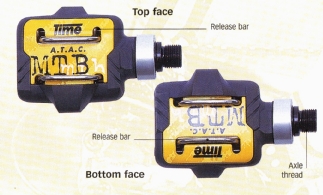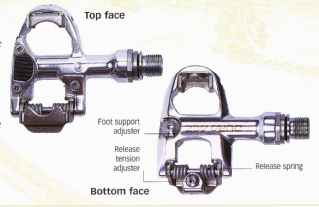Tools needed for most repair/maintenance work on pedals:
- 15mm bike wrench
- Allen key in multi-tool
- Stiff brush
- Degreasers
- Oil
Clipless pedals were developed in response to the racing cyclist’s need to apply power throughout the entire pedal revolution. They hold the foot to the pedal by locking onto a cleat attached to the sole of the shoe. The mechanism that holds the cleat is spring-loaded -- the foot is released by turning the heel outward.
The release spring is an essential working part and must be kept clean and well lubricated. Use light oils on road pedals and heavier oils on off-road pedals. Wipe oil off the pedal body to stop your foot from slipping. The mechanism lets the foot pivot around its long axis during each revolution. The oil applied to the release spring is enough to keep the mechanism working well.Off-Road Pedals
Off-road pedals are equipped with retention mechanisms on both sides so that the rider’s feet can attach to the pedal no matter which way up it is. The pedals also let mud pass through to prevent them from becoming clogged.
Time off-road pedal
The few moving parts of this simple pedal are protected in the body of the pedal. Keep the parts clean and dribble a little heavy oil into the point where the release bar enters the pedal body. If necessary, replace the bearings and axles (see Prev page).
Pedal components: Top face: Release bar; Bottom face: Release bar, axle thread

Shimano off-road pedal
The open design of this pedal allows good mud clearance but exposes the pedal’s retention mechanism to the elements. Clean and degrease the pedals regularly and lubricate the moving parts with a heavy lubricant. The release tension adjuster is on the back plate of this double-sided pedal.
Pedal components: Top face: space, release tension adjuster; Bottom face, retention mechanism

Road Pedals
Road pedals are light, supportive, and, because of the greater speeds involved in road riding, aerodynamic. They need to engage and release the feet with equal ease, as well as holding the foot securely. Ideally, you should be able to adjust them according to how much movement your feet make during pedaling.
Time road pedal
These pedals offer a range of movement that can be adjusted to suit the requirements of individual riders. Keep them well maintained by scrubbing regularly with degreaser, using a stiff brush. Wash this off, then lubricate the release spring with heavier oil, dribbling it from a can.
Pedal components: Top face: Pedal body, Retention mechanism; Bottom face: Release spring

Look road pedal
A small Allen bolt in the center of these easy-to- maintain pedals alters the degree to which the foot can pivot when pedaling. Adjust the foot-release tension via the yellow button on the pedal’s back plate. Every now and then, dribble oil between the back plate and body.
Pedal components: Top face: Pedal body, Release tension adjuster, Pivot adjuster; Bottom face: Back plate

Shimano road pedal
The release spring of this pedal is exposed. Degrease and wash the pedals regularly, then lubricate the release spring. The pedal is one-sided, with its release tension adjuster under the release spring. An adjustable pad gives the feet n support. The adjustment bolt is beneath the pedal at the end of its axle.
Pedal components: Top face: Foot support adjuster, Release tension adjuster; Bottom face: Release spring
